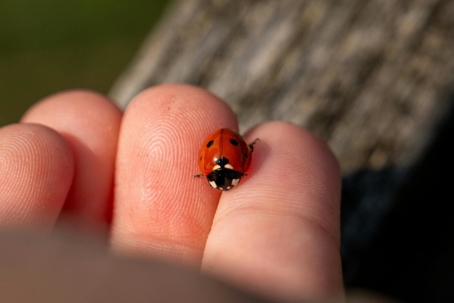Can Ladybugs Bite?
Yes, ladybugs can bite people or pets, but it’s extremely rare and usually not harmful:
Ladybugs are relatively harmless, and these beetles are generally considered beneficial insects because they eat aphids and other garden pests.
They do not have strong mandibles for chewing, so any bite is usually minor and accidental, often when the insect is handled or feels threatened.
They are more likely to release a yellowish fluid from their legs (reflex bleeding) when stressed, which can irritate skin but is not toxic.
Ladybugs can bite, but it’s rare, superficial, and harmless in nearly all cases. The bigger concern with ladybugs is their tendency to aggregate indoors in large numbers, which can be a nuisance rather than a health risk.
Do Ladybugs Bite?
Ladybugs are very unlikely to bite, but certain situations can make it more probable—usually when the insect feels threatened or is handled roughly:
Handling or Crushing: If you or a pet pick up or squeeze a ladybug, it may try to bite as a defensive reaction. This is rare because their mandibles are small, so bites are usually superficial or just feel like a tiny pinch.
Feeling Threatened: Ladybugs may bite if they are trapped between fingers, clothing, or under a pet’s paw. They also secrete a yellowish fluid (reflex bleeding) when stressed, which can irritate skin.
Indoor Encounters: Some species, like the Asian lady beetle, are more likely to enter homes and congregate in large numbers. Handling or disturbing clusters of these ladybugs can trigger defensive bites or secretions.
Pets Investigating Ladybugs: Curious dogs or cats may try to bite or eat a ladybug. The bite itself is harmless, but swallowing large numbers, especially Asian lady beetles, could cause mild stomach upset.
Ladybug bites are extremely rare and rarely break the skin. The “bite” is usually a minor pinch, often unnoticed. The main defensive behavior is reflex bleeding, which is more irritating than painful. Risk to pets is minimal unless they eat many ladybugs at once.
Ladybug Bites
Ladybug bites are generally low-risk, but it’s helpful to understand the possible effects and situations where minor issues could arise:
Skin Irritation
A bite may leave a tiny red mark and cause mild itching or tenderness.
More commonly, skin irritation comes from the yellow fluid ladybugs secrete when stressed (reflex bleeding), which can temporarily stain skin and clothes and sometimes cause minor irritation.
Allergic Reactions
Rarely, some individuals may have an allergic reaction to a ladybug bite or secretions.
Symptoms could include redness, swelling, or itching at the bite site.
Severe allergic reactions are extremely uncommon.
Risk to Pets
Ladybugs are not toxic, so a single bite or nibble by a pet is harmless.
Problems could arise if a pet ingests a large number of ladybugs, particularly Asian lady beetles, which may cause vomiting or mild digestive upset.
Secondary Infection
Since bites are superficial, the risk of infection is very low, but scratching the area could introduce bacteria.
Basic cleaning of the bite site with soap and water is sufficient to prevent this.
Ladybug bites are mostly harmless. The main “risks” are minor irritation, very rare allergic reactions, or digestive upset in pets if ingested in large quantities. No serious medical complications are associated with ladybug bites.
What Do Ladybug Bites Look Like?
Ladybug bites are extremely rare and usually minor. When they do occur, here’s what they typically look like:
Size and Shape: Very small, often pinprick-sized. Usually circular or slightly raised.
Color: Can appear red or pink at the site of the bite. If the ladybug’s defensive fluid (reflex bleeding) contacts the skin, there may be a yellowish or orange tintaround the area.
Texture and Sensation: Mildly raised or bumpy in some cases. Slight itching or tenderness is possible, but pain is minimal.
Duration: Typically resolves within a few hours to a day. Any redness or irritation usually fades quickly.
Ladybugs do not have strong mandibles, so bites rarely break the skin. Most “bites” are so minor that people don’t even notice them. The main sign of interaction with a ladybug is often skin irritation from their secreted defensive fluid, not an actual bite.
What To Do About Ladybug Bites
If you are bitten by a ladybug, the good news is that the bite is usually minor and harmless. Here’s what to do about it:
Clean the Area
Wash the bite site with soap and warm water to remove any bacteria or residue from the ladybug’s defensive secretions.
Pat dry with a clean towel.
Reduce Irritation
Apply a cold compress or ice pack for 5–10 minutes to minimize redness, swelling, or itching.
For persistent itching, a mild over-the-counter anti-itch cream (like hydrocortisone or calamine lotion) can be applied.
Monitor for Reactions
Typical reactions are very mild and resolve quickly.
Watch for signs of allergic reactions, such as significant swelling or redness, rash spreading beyond the bite site, and/or difficulty breathing or dizziness (extremely rare).
If any severe symptoms occur, seek immediate medical attention.
Avoid Scratching
Scratching can introduce bacteria and increase the risk of infection.
Keep the area clean and let it heal naturally.
Prevent Future Bites
Avoid handling ladybugs directly.
If pets are involved, discourage them from chewing or eating ladybugs, especially Asian lady beetles, which can cause mild stomach upset if ingested in large numbers.
Most ladybug bites require nothing more than cleaning and monitoring. They are not venomous and rarely cause complications.

